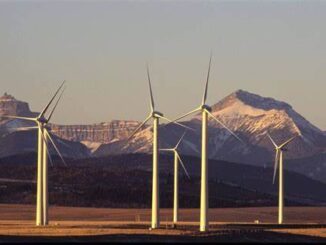
World nations must agree to phase out unabated fossil fuels “no later than 2050” and earlier if possible, says Steven Guilbeault – with any residual oil and gas emissions mitigated thanks to carbon capture and storage technology, he told EURACTIV in an interview.
Steven Guilbeault is Canada’s minister of environment and climate change. A founding member of the Quebec environmental group Équiterre, he was director and campaign manager for the Quebec chapter of Greenpeace for ten years.
He spoke to EURACTIV on the sidelines of the 7th Ministerial on Climate Action (MoCA) in Brussels on 12 July.
INTERVIEW HIGHLIGHTS:
- Canada aligns with Europe’s objective to accelerate the deployment of renewables, increase energy efficiency and reduce dependency on fossil fuels at the COP28 summit in Dubai.
- Ottawa will soon table regulations for a net-zero electricity grid by 2035.
- Canada has “a more agnostic view” than the European Commission about which sectors should or shouldn’t use carbon capture and storage (CCS) technology.
- “2023 is the year” when rich nations will meet their $100 billion commitment to developing nations on climate change.
- But emerging like China, India, and Brazil must also contribute to the climate effort, according to their capacity.
/////
The EU has outlined three objectives for COP28: 1) a tripling of renewables by 2030, 2) a doubling in the annual gains from energy efficiency, and; 3) an acceleration in the phaseout of fossil fuels. Does Canada subscribe to those three objectives?
Yes, we do, absolutely. We agree we need to accelerate the deployment of renewables, increase energy efficiency and reduce our dependency on fossil fuels.
The EU is pushing for a phase-out of “unabated” fossil fuels “well ahead of 2050”. Does Canada support a date for this?
In its April communiqué, the G7 agreed that we needed to eliminate unabated fossil fuels at the latest by 2050. And I think that we will collectively strive to do this more rapidly. The discussion has started, and it will undoubtedly continue until COP28.
As you probably know, we’ve never agreed on language around eliminating the use of unabated fossil fuels as part of a COP decision. So if we can do it this year, it would be the first time.
The phaseout date will be one of the key topics for discussion at the COP28 summit later this year. What is Canada’s stance on this?
Currently, our position is that it should be done no later than 2050. We’re certainly open to a conversation to see whether we can agree on an earlier date and what it means.
It’s important to set ourselves some objectives and targets. But it’s equally important that we understand our capacity to reach those objectives – even if that is 20 or 25 years into the future.
What does Canada understand by “abated” fossil fuels?
Well, if you look at our current Emissions Reduction Plan for 2030, presented in March last year, it presents a detailed mapping of what needs to happen in each of our economic sectors for Canada to achieve our 2030 targets.
If you look at the reports from the Intergovernmental Panel on Climate Change (IPCC) or the International Energy Agency (IEA), we know that we will likely still use fossil fuels in a carbon-neutral world by 2050. But we will be using far less fossil fuels than today.
The numbers broadly point in the same direction: we will likely go from around 100 million barrels of oil per day to something like 25-30 million barrels per day – a 75% reduction.
In addition, the fossil fuels we would use in 2050 will likely not be for combustion – they would be for industrial processes, asphalt, and things like that. But we need to ensure that the fossil fuels we are using in a carbon-neutral world in 2050, or maybe soon before, are as low-emitting as possible and that all of the emissions resulting from the production of those fossil fuels are either captured and sequestered, or offset in one way or another.
So that’s what we mean by “abated” fossil fuels instead of “unabated”.
How does that translate in terms of action? Norway has been pioneering carbon capture and storage (CCS) technology for many years but has struggled to deploy it commercially on a wide scale. How far advanced is Canada in deploying this technology on its own territory?
The first thing I should say is that, for us, carbon capture and storage is not a magic bullet. It’s not the solution to the climate crisis, it’s part of a toolbox of solutions we need to deploy.
As I said in the beginning, we need to rapidly increase the deployment of renewables, increase energy efficiency, move towards electrification in our transportation, and decarbonise our industrial and electricity sectors. All these things need to happen fast.
On CCS, both the International Energy Agency (IEA) and the Intergovernmental Panel on Climate Change (IPCC) refer to it as a necessary technology for us to be able to achieve carbon neutrality around 2050.
In Canada’s case, we need to reduce our annual emissions by about 300 megatons per year by 2030, compared to 2005 levels. Of that, about 10 to 15 megatons would come from CCS.
It’s an estimation, we’re still finalising those numbers, but it’s a small portion of our overall emission reduction plan. We don’t think CCS will enable us to achieve 50% or even 30, 25 or 20% of our emission reductions; it will be less.
Does Canada support CCS to mitigate emissions from oil sands ? Or do you believe CCS should be prioritised to reduce emissions in other sectors like steel, cement or chemicals, where carbon emissions are hard to abate?
We started deploying financial incentives for the deployment of CCS in Canada. And that would be for any industrial sector where they feel they need CCS – whether it’s the oil and gas sector, cement, steel, or even electricity generation.
We will be announcing regulations for a net-zero grid by 2035. It won’t be a fossil fuel-free grid – we anticipate some fossil fuels will still be part of our electricity mix in 2035. But the emissions from fossil fuel-producing facilities would have to be carbon captured and sequestered.
Do you assume there will still be some oil sand production left in Canada by 2050?
I would point to a recent report by the Canadian energy regulator, an independent body. They published a study looking at three scenarios regarding energy demand in Canada – a business-as-usual scenario, a Canada IEA 1.5C degree compliant scenario, and an international 1.5C IEA compliant scenario.
And in those projections, the energy regulator anticipates a reduction of 50 to 75% of the production of fossil fuels in Canada by 2050 in scenarios that are 1.5C degree compliant.
So there would still be some exploitation of tar sands in Canada according to those 1.5C compliant scenarios, right?
What the Canadian energy regulator looked at these the overall oil and gas sector. Obviously, oil sands are an essential component of our oil production in Canada, but we also have conventional oil that’s still producing and offshore oil on the east coast.
So it is difficult right now to say what would be left in terms of production: would it be oil sands, conventional, offshore, or a bit of all with a proportion change? This is hard to determine right now, and I guess time will tell what will happen.
Oil sands are obviously more carbon-intensive than traditional oil. Do you believe that kind of production needs to stop, eventually?
As you may know, in Canada, constitutionally, the federal government has no regard for using natural resources – this is a provincial and territorial jurisdiction as per our Constitution.
The federal government can and is playing a role in pollution, which is why we’ve put carbon pricing in place and are about to set an objective to make electricity production carbon-neutral by 2035.
We will also be introducing regulation to cap the emissions of the oil and gas sector – a cap and cut regulation – in the coming months. Our goal is that whatever happens to production, we need to ensure that the emissions from Canada’s oil and gas sector go down over time.
The EU’s climate chief, Frans Timmermans, said CCS needs to be applied in “residual and only in hard-to-abate sectors”. Do you believe this is the right thing to do?
We have a more agnostic view of which sectors should or shouldn’t use CCS in Canada. What’s important in our view is that we see a rapid decline in the overall emissions of Canada. In fact, in the data, Canada is the best-performing G7 country in 2019-2021 regarding reducing our emissions. And that’s certainly true of the oil and gas sector.
But we feel we need to implement robust regulations to ensure emissions are declining. And then, various sectors or companies will decide whether or not they want to continue producing oil and gas using CCS or prefer doing other things.
One of the big topics of discussion at COP28 is going to be the contributions of developed countries to the UN’s Green Climate Fund. Rich nations committed back in 2009 to contribute $100 billion to the fund annually by 2020, but that objective has never been met. When do you believe it will be met?
This year. I’m confident that the data provided by the OECD – which usually provides data in the Fall – will show that 2023 is the year when we’ve met our $100 billion commitment.
And I’m also confident that, on average, between 2020 and 2025, we will get to $100 billion per year. We obviously didn’t get there in 2021 or 2022. But on average, the overall amount will be equivalent to $100 billion annually between 2020 and 2025.
What will be Canada’s contribution to that?
In Glasgow, as we were requested to do, we doubled our international climate finance commitments to $5.3 billion over the 2020-2025 period.
We’re in the process now of allocating those funds – we announced yesterday $450 million to the Green Climate Fund, which is a 50% increase compared to our previous commitment to the GCF.
And there are other contributions that we are making to climate finance through some of the work that’s being done with the World Bank, for example, or the IMF.
There are recurrent discussions ahead of COP meetings about the status of China, either as a developing nation or a developed nation. What is your view: should China still be considered a developing country or not?
Beyond whether or not we can agree on that, there is a clear recognition that unless G20 countries have Nationally Determined Contributions (NDCs) that are aligned with the 1.5C degrees target, we won’t be able to get there. Without their contribution, there is mathematically no way we can meet the 1.5C degree target.
And that certainly includes countries like Canada, the US, the European Union and Japan – but it also includes countries like China, India, and Brazil.
And clearly, some countries in the Global South have more capacity to invest in either adaptation or decarbonisation. And all those countries that can contribute should contribute to efforts to adapt or mitigate their greenhouse gas emissions.
Are you saying that China should significantly contribute to the Green Climate Fund?
I’m not talking specifically about the Green Climate Fund, I’m saying that those who can support international climate efforts, as well as national climate efforts.
And do you believe China has been doing enough of that? Or can it do better?
I think this is a conversation that needs to happen – about the role of non-traditional and non-historical donors to the international climate effort. And again, if you can contribute, you should contribute.



